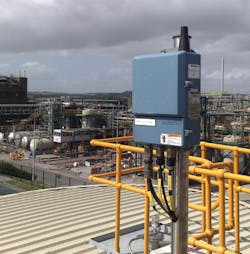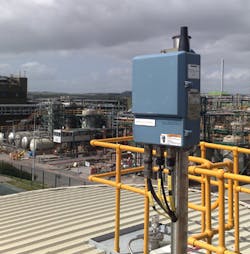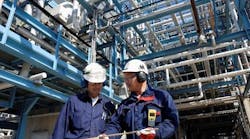As technology grows more sophisticated, supply of experienced engineering professionals runs short, and the need for key resources draws exploration efforts into harsher and more distant application environments, today’s fluid handling processes, like most other industrial systems, are becoming more automated. With these high-technology systems comes the need to facilitate communication between the device and the control system in a standardized fashion. And with more applications being deployed in remote locations, there is a growing need for a streamlined and unified approach for monitoring and controlling disparate fluid handing devices in far-off places. As such, the concept of remote operations management (ROM) is generating significant interest from suppliers and end-users alike. Among the latest examples of this heightened focus on remote applications is the Fieldbus Foundation’s FOUNDATION for ROM initiative.
How Did Foundation for ROM Come to Be?
Photo courtesy of the Fieldbus Foundation.
Larry O’Brien, marketing manager for the Fieldbus Foundation, says FOUNDATION for ROM is an initiative that has been four-plus years in the making. “It really started out as a project to integrate remote I/O into FOUNDATION fieldbus via our [High-Speed Ethernet] network,” he says. At that time, the project was called RIO (remote input-output), but as it evolved, O’Brien says the scope grew to include wired HART, WirelessHART, and ISA100.11a, as well as an HSE-based backhaul network. Ultimately, the name was changed from RIO (Remote I/O) to FOUNDATION for ROM to accommodate the project’s expanded focus.
O’Brien says FOUNDATION for ROM is based on what the Fieldbus Foundation and end-users have identified as a need that figures to grow in significance in the years to come. For example, he says as end-users continue to bring applications online in environments that are less than hospitable for humans (think offshore oil and gas exploration), fully remote operations will become more commonplace. And as remote operations continue to grow in prominence, the need for a standardized method for monitoring and controlling remote devices will also grow.
O’Brien says most remote applications today are managed by traditional remote terminal unit (RTU)-based SCADA systems, which are highly customized and don’t offer a lot of configuration flexibility to accommodate the introduction of new devices. According to the Fieldbus Foundation, the large amount of customization currently employed for remote operations in the process industries costs end-users billions of dollars a year overall, with more than half of project costs directly traceable to customization. At the field device level, the Fieldbus Foundation believes analog technology creates unnecessary work processes because of the lack of direct, bidirectional digital access to devices for commissioning and diagnostics. In fact, it estimates that instrument engineering alone can account for 20 percent of overall automation project costs.*
That said, O’Brien says the insidious thing about customization that is often overlooked is what happens in 10 years when the person that designed the customization is gone. Often, he says end-users are left with a system that nobody knows much about and are limited in what they can do with it. “FOUNDATION for ROM is promising flexibility and full configurability by the end-user without the need for a lot of customization,” says O’Brien.
The FOUNDATION for ROM Solution
FOUNDATION for ROM aims to provide end-users with a suite of technologies and additions to the FOUNDATION fieldbus specification that provide for both a wireless and wired infrastructure for remote assets and applications. This suite is designed to provide direct access to information and diagnostics in wireless and remote I/O devices. Conversely, FOUNDATION for ROM can take the data from those devices and place it into the FOUNDATION fieldbus environment for data management and quality.
The Fieldbus Foundation’s FOUNDATION for ROM initiative is intended to develop a unified digital infrastructure for asset management in remote applications ranging from tank farms and terminals to pipelines, offshore platforms, as well as original equipment manufacturer (OEM) skids. All told, O’Brien says the Fieldbus Foundation identified 24 unique applications in its initial market research for FOUNDATION for ROM.
The technology enables fieldbus connectivity to remote I/O and the leading industrial wireless protocols, including WirelessHART and ISA 100.11a. It provides an interface to these wireless technologies and uses Electronic Device Description Language (EDDL) and function blocks to ensure interoperability with FOUNDATION for ROM devices.
Within the FOUNDATION automation architecture, the H1 (31.25 kbit/s) and HSE (100 Mbit/s) fieldbus networks provide a distributed function block capability with HSE serving as a larger pipeline with increased speed and throughput. The FOUNDATION for ROM solution expands these capabilities by establishing open, non-proprietary specifications for an interface to wireless field device networks, a wired HSE backhaul, and a wireless HSE backhaul.
Security Measures
FOUNDATION for ROM is currently working within the ISA100 program to facilitate interoperability with ISA100.11a — ISA100’s first publicly available specification for industrial wireless communication — through the ISA100.15 working group. Part of this working group’s responsibility is to develop security parameters for FOUNDATION for ROM.
On the heels of the Stuxnet and Duqu malware worms, which were designed to attack industrial control systems, concerns about industrial cybersecurity are heightened, and security figures to be a key issue as end-users develop their networks for remotely monitored and controlled systems going forward. O’Brien says that while the Fieldbus Foundation has little control over security at the device level, it has built much of the security parameters developed as part of the ISA100 initiative into FOUNDATION for ROM. The backhaul protocols of FOUNDATION for ROM, in particular, are designed in line with the security parameters of ISA100.
Status of FOUNDATION for ROM
O’Brien says the specification for the remote I/O piece of FOUNDATION for ROM has been completed and is through the validation testing phase. Work on the wired HART, WirelessHART, and wireless backhaul elements is expected to be completed before this article is published in February. The specification for integrating ISA100 field devices is scheduled for completion during the 2012 calendar year.
Once all of the elements of FOUNDATION for ROM specification have moved through the validation phase, O’Brien says work will begin on developing some solid demos of the technology, which he expects will be completed by mid-2013. Further down the road, he says the Fieldbus Foundation will be evaluating other networks that might make sense for integration with FOUNDATION for ROM, such as Modbus, for example.
Ultimately, O’Brien says he sees the key advantages of FOUNDATION for ROM as its inherent ability to reduce the amount of customization and flatten the architecture when it comes to how remote devices communicate with control systems, and, perhaps most importantly, the capability it offers those who want to integrate their approach in terms of the handling of wireless devices.
“When you look at WirelessHART and ISA100, I think a lot of end-users have been sitting around waiting to see which one will come out on top,” says O’Brien. “Now, with FOUNDATION for ROM, you can experiment with both if you want.”
Matt Migliore is Flow Control’s executive director of content. He can be reached at [email protected].
* FOUNDATION for Remote Operations Management: Transforming Remote Applications, 2011, Fieldbus Foundation.



